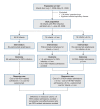Cost-effectiveness of palivizumab compared to no prophylaxis in term infants residing in the Canadian Arctic
- PMID: 28443266
- PMCID: PMC5396468
- DOI: 10.9778/cmajo.20150052
Cost-effectiveness of palivizumab compared to no prophylaxis in term infants residing in the Canadian Arctic
Abstract
Background: Hospital admissions for respiratory syncytial virus infection result in large health expenditures for Inuit infants. Palivizumab has been shown to be highly effective in reducing such admissions in preterm Inuit infants. We performed a cost-effectiveness analysis estimating the incremental cost-effectiveness ratio (ICER) for palivizumab prophylaxis per admission related to respiratory syncytial virus avoided in healthy term infants across the Canadian Arctic.
Methods: We compared universal palivizumab prophylaxis in term infants less than 6 months of age to no prophylaxis in 8 Arctic regions: the Northwest Territories, Nunavut, Nunavut without Iqaluit, the 3 subregions of Nunavut (Kitikmeot, Kivalliq and Qikiqtaaluk), the Qikiqtaaluk Region without Iqaluit, and Nunavik (northern Quebec). Costs were acquired from the territorial governments, hospitals and contracted agencies. The perspective is that of the public payer, with a 6-month timeline. In scenario A, universal prophylaxis was provided until the end of the respiratory syncytial virus season, and in scenario B, infants received prophylaxis until 5 months of age. The ICERs of scenario A were compared with those of scenario B.
Results: Under scenario A, the cost per admission avoided was as high as $546 115 in the Northwest Territories, compared with a cost savings of $36 145 in the Kitikmeot Region. Under scenario B, the ICER showed cost savings of $48 549 in the Kitikmeot Region and $2731 in the Kivalliq Region, with low ICERs in Nunavik of $15 601.
Interpretation: Considerable cost savings were found for the Kitikmeot Region with universal palivizumab prophylaxis in term infants with both scenarios, whereas cost savings were found for the Kivalliq Region with scenario B. Stopping prophylaxis at 5 months of age was a more cost-effective strategy in all regions except the Kitikmeot Region. Nunavik had low ICERs, and prophylaxis should be considered for this region.
Conflict of interest statement
Competing interests: Joan Robinson received grants from Abbott and Medimmune during the conduct of the study.This article has been peer reviewed.
Figures


Comment in
-
Reducing the burden of lower respiratory tract infections in infants in the Canadian Arctic.CMAJ. 2017 Mar 27;189(12):E450-E451. doi: 10.1503/cmaj.161293. CMAJ. 2017. PMID: 28385860 Free PMC article. No abstract available.
References
-
- Banerji A. High rates of hospitalisation for bronchiolitis in Inuit children on Baffin Island. Int J Circumpolar Health. 2001;60:375–9. - PubMed
-
- Carson JB, Postl BD, Spady D, et al. Lower respiratory tract infections among Canadian Inuit Children. Int J Circumpolar Health. 1984;84:226–8.
-
- Banerji A, Greenberg D, White LF, et al. Risk factors and viruses associated with hospitalization due to lower respiratory tract infections in Canadian Inuit children: a case-control study. Pediatr Infect Dis J. 2009;28:697–701. - PubMed
LinkOut - more resources
Full Text Sources
Other Literature Sources
